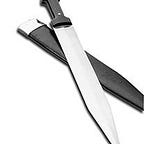Two-handed Swords — Monsters of War
Two-handed swords were called war-swords in the early Middle Ages and great swords during the High Middle Ages and the Renaissance. These weapons were capable of destroying an opponent’s shield, shear through mail, and ruin helms. Size wise, they tended to be slightly longer than traditional swords. Technically, however, the two-handed sword belongs to the Renaissance period. These swords could be over six feet long but surprisingly light at 4 –6 lbs, and unlike previous versions were only effective with two hands They were well balanced and best with wide sweeping blows and countered weapons like halberds and pikes while also taking the role of spears. Soldiers wielding them often received twice the regular soldier’s wages. DO YOUR RESEARCH FIRST, if you plan to buy a two-handed sword on the Internet. The following are some of the better two-handed swords you can find online, some of which can be used with one hand but are most effective with two.
- Bosworth Longsword
This sword gets its name from the bloody late 15th-century battle during the War of the Roses. The fast and capable Bosworth Longsword is perfect for the deadly “Mastercut” techniques familiar with double-handed blades of the time. A longsword like this was capable of quick, dangerous cuts as well as forceful, damaging thrusts. This ebony-toned tool is ideal for foot combat or knightly challenge. The Bosworth features a darkened finish, and the pre-sharpened blade has undergone stringent testing. 1065 high carbon steel has been used to make the blade.
2. Hero’s Warsword
This massive claymore gets its inspiration from the Bruce clan of the 13th century. Robert the Bruce wielded a similar sword, they say. While the claim is debatable, historically this sword does belong to the period when knights wore mail, barrel helms and small pieces of plate, just as King Robert did. The sheer size of the sword produced power that could cause havoc on armor of that period. Large swords like these were not worn but carried over one’s shoulder with the flat of the blade down; also, there was no scabbard for this monster. In this version, the long blade is fullered and features a flattened cross section. High carbon steel is used for the blade, and the grip is wood wrapped in cord for a firm clasp.
3. The Freedom Fighter Early Scottish Claymore
If Robert of Bruce is on any list, it’s only appropriate that William Wallace is there too. The two are among the most recognized figures in Scottish history. This early, two-handed claymore takes inspiration from William Wallace, Scotland’s greatest freedom fighter. This sword measures a massive 61 inches in overall length and is made of high carbon steel blade. The handle and a portion of the sword above the cross guard are leather-wrapped.
4. Crusader Chopper
This weapon is perhaps not a sword in the traditional sense, but it looks so cool that we are putting it on the list. There are no historical names for this sword; still, it does appear in manuscripts from the period. This version is a single-edge blade which is broad and flat. The long two-handed grip offers a lot of leverage, which helps generate tremendous power. The Crusader Chopper is hand forged of high-carbon steel and features wooden scales on the grip that complement the antique copper fittings.
5. Hobbit Glamdring the Sword of Gandalf
As per Tolkien’s legend, the sword named Glamdring was forged by the High Elves of the West in the city of Gondolin. The sword survived and was found thousands of years later by Gandalf and his friends. This stunning and authentically detailed replica is a reproduction of the actual filming prop used in the movie The Hobbit: An Unexpected Journey. The sword is made of AUS-6 stainless steel blade and features solid metal hilt parts, faux blue jewel gemstones, and a leather-wrapped grip.
